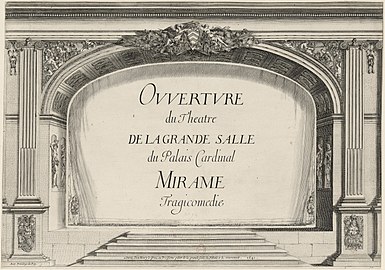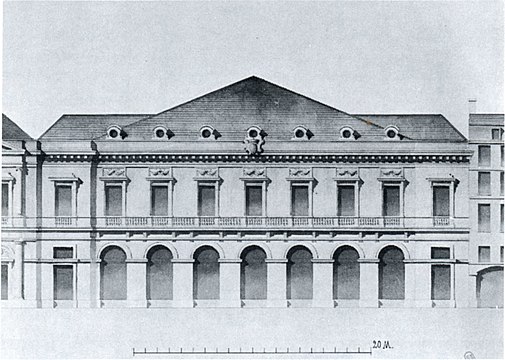Théâtre du Palais-Royal (rue Saint-Honoré)

The Théâtre du Palais-Royal (or Grande Salle du Palais-Royal) on the
First theatre
Cardinal Richelieu
The Palais-Royal was originally known as the Palais-Cardinal, since it was built in the 1630s as the principal residence of
- Architectural plans with the Grande Salle
-
Detail plan of 1673 showing the Petite Salle in yellow and the Grande Salle in blue
-
General ground-floor plan of 1679 with the Grande Salle in blue
(48°51′46″N 2°20′14″E / 48.862894°N 2.337255°E)
The hall, initially known as the Grande Salle du Palais-Cardinal (Large Hall of the Palais-Cardinal), was one of the earliest theatres in France to use the
The theatre opened on 14 January 1641 with a performance of
On 7 February 1641, Richelieu produced in the Grande Salle the last of the political ballets of
- Depictions of the Grande Salle of the Palais-Cardinal
-
Proscenium arch with a drop-curtain for Desmarets' Mirame (1641), engraving by Stefano della Bella
-
Perspective set for Mirame, Act 1, engraving by Stefano della Bella
-
The royal family and Richelieu at the ballet La Prospérité des Armes de la France, which premiered on 7 February 1641 (grisaille by Justus van Egmont)
Gabriel Gilbert's play Téléphonte was probably produced in the theatre in 1641 and performed by the combined troupes of the Théâtre du Marais and the Hôtel de Bourgogne.[15] Richelieu's last production there was Desmarets' play Europe, a political allegory celebrating Richelieu's career and "the triumph of France over her enemies on the Continent."[16] The play was in rehearsal in the Grande Salle when Richelieu died.[16]
Cardinal Mazarin
Upon Richelieu's death on 4 December 1642, he left the property to Louis XIII, and it became known as the Palais-Royal, although the name Palais-Cardinal sometimes still continued to be used.
The first, on 28 February 1645, was a comédie italienne, which may have been
Molière
The troupe of
Paris Opera

On the death of his old collaborator,

Several of Lully's operas (
The Opera's first theatre was destroyed by fire on 6 April 1763.
Second theatre

The City of
The new theatre opened on 20 January 1770 with a performance of Rameau's
The theatre continued to be used by the Opera until 8 June 1781, when it too was destroyed by fire. The
- Architectural drawings of the second Salle du Palais-Royal (1770–1781)
-
Facade of Moreau's opera house
-
Transverse section
-
Ground-level floorplan
-
First-loges level
See also
References
- Notes
- ^ a b c d Coeyman 1998, pp. 60–71.
- ^ a b Pitou 1983, pp. 26–30.
- ^ Ayers 2004, p. 47.
- ^ Gady 2005, p. 302.
- ^ a b Powell 2000, p. 21.
- ^ Lawrenson 1986, p. 157, 204.
- ^ Wiley 1960, p. 198.
- ^ Goldfarb 2002, p. 240.
- ^ Clarke 1998, pp. 1–2, 19–20.
- ^ Bjurström 1962, pp. 117–118.
- ^ a b c Translated and quoted by Scott 1990, p. 87.
- ^ Scott 1990, p. 87.
- ^ Isherwood, 1973, pp. 107–113. According to Bjurstrom 1962, p. 122, Torelli first arrived in Paris in June 1645, and his first production there was the Paris premiere in December 1645 of La finta pazza in the large hall of the Hôtel du Petit-Bourbon. He had also designed the scenery and machines for this opera's premiere in Venice during the Carnival season of 1641.
- ^ Isherwood 1973, p. 109. Bjurström 1962, p. 116, states Prosperité des armes de France was produced in the same setting as Mirame, based on the Mémoires de Michel de Marolles, Amsterdam 1755, vol 1, p. 237. However, Marolles only states that the machines, not the settings, were the same as for Mirame.
- ^ Lancaster 1966, p. 390; Lawrenson 1986, p. 156.
- ^ a b Wiley 1960, p. 266.
- ^ Ayers 2004, p. 47; Bjurstrom 1961, p. 123.
- ^ Kleinman 1985, pp. 139, 145.
- ^ Kleinman 1985, pp. 175–176.
- ^ Kleinman 1985, p. 184.
- ^ Powell 2000, p. 21–22.
- ^ Powell 2000, p. 22; Anthony 1992; Isherwood 1973, p. 121.
- ^ Nestola 2007, pp. 125–146.
- ^ Naudeix 2022, pp. 219–220.
- ^ Isherwood 1973, p. 121.
- ^ Isherwood 1973, p. 123.
- ^ Scott 1990, p. 89.
- ^ a b c Isherwood 1973, p. 125.
- ^ Garreau 1984, pp. 417–418.
- ^ Harris-Warrick, Rebecca (1992). "Paris. 2. 1669–1725" in Sadie (1992) vol. 3, pp. 856–857.
- ^ Simeone 2000, p. 181.
- ^ Pitou 1983, p. 26; Ayers 2004, pp. 47–48.
- ^ Harris-Warrick, Rebecca. "Paris. 3. 1725–1789" in Sadie 1992, vol. 3, pp. 860–864.
- ^ Mead 1991, p. 45.
- ^ Pitou 1983, p. 26, gives a capacity of 2,500. Simeone 2000, p. 181, says it held 2,000.
- ^ Pitou 1983, p. 26, and Mead 1991, p. 45, both say it opened on 20 January 1770. Simeone 2000, p. 181, says it opened on 26 January 1770.
- ^ Pitou 1985, pp. 566–567.
- Sources
- Anthony, James R. (1992). "Mazarin, Cardinal Jules", vol. 3, p. 287, in ISBN 9781561592289.
- Ayers, Andrew (2004). The Architecture of Paris. Stuttgart: Axel Menges. ISBN 9783930698967.
- Bjurström, Per (1962). Giacomo Torelli and Baroque Stage Design, 2nd revised edition, translated from the Swedish. Stockholm: Almqvist & Wiksell. OCLC 10226792.
- Clarke, Jan (1998). The Guénégaud Theatre in Paris (1673–1680). Volume One: Founding, Design and Production. Lewiston, New York: The Edwin Mellen Press. ISBN 9780773483927.
- Coeyman, Barbara (1998). "Opera and Ballet in Seventeenth-Century French Theatres: Case Studies of the Salle des Machines and the Palais Royal Theater" in Radice 1998, pp. 37–71.
- Gady, Alexandre (2005). Jacques Lemercier, Architecte et ingénieur du Roi. Paris: Éditions de la Maison des sciences de l'homme. ISBN 2735110427.
- Garreau, Joseph E. (1984). "Molière", pp. 397–418 in McGraw-Hill Encyclopedia of World Drama, Stanley Hochman, editor in chief. New York: McGraw-Hill. ISBN 9780070791695.
- Goldfarb, Hilliard Todd, editor (2002). Richelieu: Art and Power. Ghent: Snoeck-Ducaju & Zoon. ISBN 9789053494073.
- Isherwood, Robert M. (1973). Music in the Service of the King. France in the Seventeenth Century. Ithaca: Cornell University Press. ISBN 9780801407345.
- Kleinman, Ruth (1985). Anne of Austria, Queen of France. Columbus, Ohio: Ohio State University Press. ISBN 9780814204290.
- OCLC 1240479691.
- Lawrenson, T. E. (1986). The French Stage and Playhouse in the XVIIth Century: A Study in the Advent of the Italian Order, second edition. New York: Ams Press. ISBN 9780404617219.
- Mead, Christopher Curtis (1991). Charles Garnier's Paris Opera. Cambridge, Massachusetts: The MIT Press. ISBN 978-0-262-13275-6.
- Naudeix, Laura (2022). "Opera in France c. 1640 – c. 1710", pp. 215–239, in The Cambridge Companion to Seventeenth-Century Opera, edited by Jacqueline Waeber. Cambridge University Press (ISBN 9780521530460.
- Nestola, Barbara (2007). "L'Egisto fantasma di Cavalli: nuova luce sulla rappresentazione parigina dell Egisto ovvero Chi soffre speri di Mazzocchi e Marazzoli (1646)", Ricercare, vol. 19, no. 1/2 (2007), pp. 125–126. JSTOR 41701476.
- Pitou, Spire (1983). The Paris Opéra: An Encyclopedia of Operas, Ballets, Composers, and Performers. Genesis and Glory, 1671–1715. Westport, Connecticut: Greenwood Press. ISBN 9780313214202.
- Pitou, Spire (1985). The Paris Opera: An Encyclopedia of Operas, Ballets, Composers, and Performers. Rococo and Romantic, 1715-1815. Westport, Connecticut: Greenwood Press. ISBN 9780313243943.
- Powell, John S. (2000). Music and Theatre in France 1600–1680. Oxford: Oxford University Press. ISBN 9780198165996.
- Radice, Mark A., editor (1998). Opera in Context: Essays on Historical Staging from the Late Renaissance to the Time of Puccini. Portland, Oregon: Amadeus Press. ISBN 9781574670325.
- ISBN 978-1-56159-228-9.
- Scott, Virginia (1990). The Commedia dell'Arte in Paris, 1644–1697. Charlottesville: University Press of Virginia. ISBN 0813912555.
- Simeone, Nigel (2000). Paris: a musical gazetteer. Yale University Press. ISBN 978-0-300-08053-7.
- Wiley, W. L. (1960). The Early Public Theatre in France. Cambridge, Massachusetts: Harvard University Press. ISBN 9780837164496.
External links
 Media related to Grande salle du Palais-Cardinal at Wikimedia Commons
Media related to Grande salle du Palais-Cardinal at Wikimedia Commons Media related to Première salle du Palais-Royal at Wikimedia Commons
Media related to Première salle du Palais-Royal at Wikimedia Commons Media related to Seconde salle du Palais-Royal at Wikimedia Commons
Media related to Seconde salle du Palais-Royal at Wikimedia Commons











